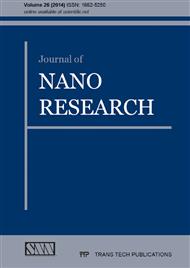[1]
T.B. Flanagan, W.A. Oates, The palladium-hydrogen system, Annu. Rev. Mater. Sci. 21 (1991) 269-304.
DOI: 10.1146/annurev.ms.21.080191.001413
Google Scholar
[2]
P. Kumar, L. Malhotra, Palladium capped samarium thin films as potential hydrogen sensors, Mater. Chem. Phys. 88 (2004) 106-109.
DOI: 10.1016/j.matchemphys.2004.06.038
Google Scholar
[3]
A. G. Knapton, Palladium Alloys for Hydrogen Diffusion Membranes, Platinum Metals Rev. 21 (1977) 44-50.
Google Scholar
[4]
A. Pundt, R. Kirchheim, Hydrogen in metals: microsstructural aspects, Annu. Rev. Mater. Res. 36 (2006) 555-608.
DOI: 10.1146/annurev.matsci.36.090804.094451
Google Scholar
[5]
R. Kirchheim, Hydrogen solubility and diffusivity in defective and amorphous metals, Prog. Mater. Sci. 32 (1988) 261-325.
DOI: 10.1016/0079-6425(88)90010-2
Google Scholar
[6]
R. Kirchheim, Interaction of hydrogen with dislocations in palladium—I. Activity and diffusivity and their phenomenological interpretation, Acta Metall. 29 (1981) 835-843.
DOI: 10.1016/0001-6160(81)90126-7
Google Scholar
[7]
T. Mütschele, R. Kirchheim, Segregation and diffusion of hydrogen in grain boundaries of palladium, Scripta Metall. 21 (1987) 135-140.
DOI: 10.1016/0036-9748(87)90423-6
Google Scholar
[8]
T. Mütschele, R. Kirchheim, Hydrogen as a probe for the average thickness of a grain boundary, Scripta Metall. 21 (1987) 1101-1104.
DOI: 10.1016/0036-9748(87)90258-4
Google Scholar
[9]
F. Besenbacher, J.K. Norskow, M.J. Puska, S. Holloway, Interaction of hydrogen with defects in metals, Nucl. Instrum. Methods Phys. Res. B 7-8 (1985) 55-66.
Google Scholar
[10]
Y. Fukai, N. Ōkuma, Evidence of Copious Vacancy Formation in Ni and Pd under a High Hydrogen Pressure, Jpn. J. Appl. Phys. 32 (1993) L1256-L1259.
DOI: 10.1143/jjap.32.l1256
Google Scholar
[11]
Y. Fukai, N. Ōkuma, Formation of Superabundant Vacancies in Pd Hydride under High Hydrogen Pressures, Phys. Rev. Lett. 73 (1994) 1640-1643.
DOI: 10.1103/physrevlett.73.1640
Google Scholar
[12]
R.D. Field, D.J. Thoma, In-situ hydrogen charging of Pd and Pd-Rh in the TEM, Scripta Mater. 37 (1997) 347-353.
DOI: 10.1016/s1359-6462(97)00094-8
Google Scholar
[13]
R. Kirchheim, Reducing grain boundary, dislocation line and vacancy formation energies by solute segregation. I. Theoretical background, Acta Mater. 55 (2007) 5129-5138.
DOI: 10.1016/j.actamat.2007.05.047
Google Scholar
[14]
R. Kirchheim, On the solute-defect interaction in the framework of a defactant concept, Int. J. Mater. Res. 100 (2009) 483-487.
DOI: 10.3139/146.110065
Google Scholar
[15]
A. Pundt, M. Getzlaff, M. Bode, R. Kirchheim, R. Wiesendanger, H-induced plastic deformation of Gd thin films studied by STM, Phys. Rev. B 61 (2000) 9964-9967.
DOI: 10.1103/physrevb.61.9964
Google Scholar
[16]
P.J. Schultz, K.G. Lynn, Interaction of positron beams with surfaces, thin films, and interfaces, Rev. Mod. Phys. 60 (1988) 701-779.
DOI: 10.1103/revmodphys.60.701
Google Scholar
[17]
M.A. Hamstad, A Review: Acoustic Emission as a Tool for Composite Materials Studies, Experimental Mechanics 26 (1986) 7-13.
DOI: 10.1007/bf02319949
Google Scholar
[18]
W. Anwand, G. Brauer, M. Butterling, H.-R. Kissenger, A. Wagner, Design and Construction of a Slow Positron Beam for Solid and Surface Investigations, Defect and Diffusion Forum 331 (2012) 25-40.
DOI: 10.4028/www.scientific.net/ddf.331.25
Google Scholar
[19]
J. Čížek, O. Melikhova, M. Vlček, F. Lukáč, M. Vlach, I. Procházka, W. Anwand, G. Brauer, A. Mücklich, S. Wagner, H. Uchida, A. Pundt, Hydrogen-induced microstructural changes of Pd films, Int. J. Hydrogen Energy 38 (2013), 12115-12152.
DOI: 10.1016/j.ijhydene.2013.03.096
Google Scholar
[20]
A. Pundt, P. Pekarski, Buckling of thin niobium-films on polycarbonate substrates upon hydrogen loading, Scripta Mater. 48 (2003) 419-423.
DOI: 10.1016/s1359-6462(02)00461-x
Google Scholar
[21]
A. Pundt, E. Nikitin, P. Pekarski, R. Kirchheim, Adhesion energy between metal films and polymers obtained by studying buckling induced by hydrogen, Acta Mater. 52 (2004)1579-1587.
DOI: 10.1016/j.actamat.2003.12.003
Google Scholar


